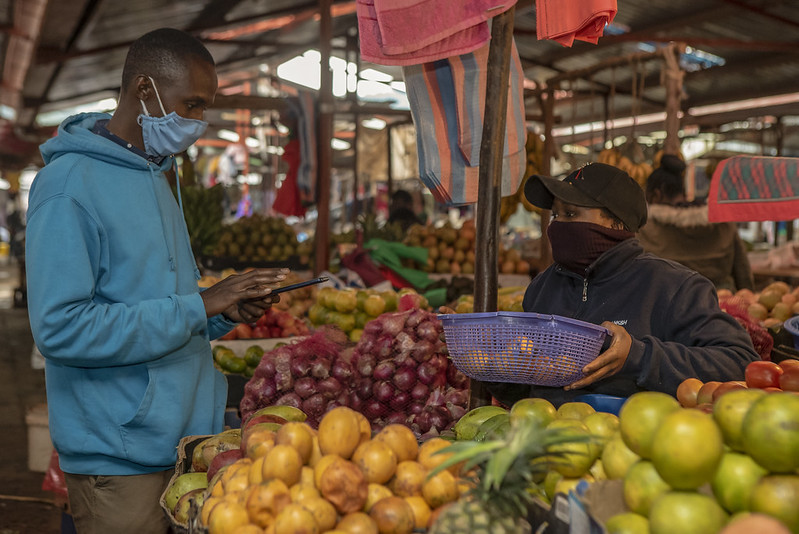The inflation rate in March 2022 was more than twice the rate of 3.7 per cent recorded in March 2021. This jump in the CPI by 5.5 percentage points between March 2021 and March 2022 constitutes the highest increase in any 12‑month period since the beginning of the series in January 2019.1Global estimates were calculated as of January 2019 for the purposes of this blog. These global figures are not available in ILOSTAT.
The overall rise in inflation reflects the effects of the COVID-19-related lockdowns in 2020 and 2021. More recently, though, it has been driven by a surge in energy and food prices, especially since the start of the war in Ukraine on 24 February 2022.
This conflict has inflicted a major shock on commodity markets, disrupting global patterns of trade, production and consumption in ways that are likely to keep prices at high levels in the coming years.
According to data on the global commodity market from March 2022, wheat and oil are currently both about 50 per cent more expensive than they were a year ago. The prices of other cereal grains are also rising. For importing countries, these price increases present a significant obstacle to economic growth and livelihood, potentially raising social and political tensions.
Food prices, in particular, are now soaring. In March 2022, they were 9.1 per cent higher than in March 2021.
However, it should be noted that prices, especially food prices, were rising even before the war in Ukraine started. COVID-19-related restrictions on the cross-border movement of labour and disruptions in global supply chains pushed production costs up and reduced competition. The recent price increases triggered by the war in Ukraine have simply aggravated the existing price pressure due to the confluence of high demand and persistent supply shortages.
It is not only the supply side that was affected by the pandemic. Consumer demand and spending – particularly on travel, entertainment and other “optional” items – decreased substantially as people were locked down, put on furlough or made redundant. The sharp drop in demand for some goods and services led to a decline in the prices of certain items, such as fuel, in the CPI basket. As a result, general consumer price inflation actually slowed down at the global level between March 2020 and March 2021.
As the pandemic-related restrictions were gradually eased toward the end of 2021, growing demand coupled with higher energy and shipping costs led to a rapid increase in consumer prices. In all regions except Eastern and South-Eastern Asia, annual inflation accelerated in the second half of 2021, especially after the easing of COVID‑19‑related restrictions.
The surge in consumer price inflation is having a major impact on the living standards of households, especially lower-income households, which tend to spend a larger share of their income on food and other necessities. Households now face the prospect of deteriorating personal finances against the backdrop of weaker national economic growth and a delayed post‑crisis recovery. The coming months may not bring much relief given that the response to new COVID‑19 outbreaks in some Chinese cities is disrupting production in that country and affecting global supply chains, while the ongoing war in Ukraine is creating tremendous uncertainty with regard to commodity prices.
Methodology
The consumer price index (CPI) measures the average change over time in the prices of goods and services that a typical household consumes, such as food, beverages, tobacco, clothing, housing, fuels, household appliances, transport, health and telecommunications. For more information, see statistics on consumer prices.
Regional estimates of consumer price inflation are calculated as a weighted geometric average of national price indices, with the weights being the respective countries’ estimated gross domestic product in 2017 in current dollars based on purchasing power parity (available from the World Bank). The regional CPI estimates are based on data for all countries for which CPI series are available for the period from January 2019 to March 2022.
Regional CPI estimates are calculated for the official country groupings (geographical regions) used by the United Nations in reporting on the indicators of progress towards the Sustainable Development Goals (SDGs). These country groupings differ from the regions and subregions presented on ILOSTAT.
| SDG country grouping | Number of countries and territories with available CPI data |
| Central and Southern Asia | 10 |
| Eastern and South-Eastern Asia | 17 |
| Europe and Northern America | 42 |
| Latin America and the Caribbean | 34 |
| Northern Africa and Western Asia | 20 |
| Oceania | 8 |
| Sub-Saharan Africa | 43 |
| World | 174 |
Author
-

Valentina Stoevska
Valentina Stoevska is a Senior Statistician in the ILO Department of Statistics.








